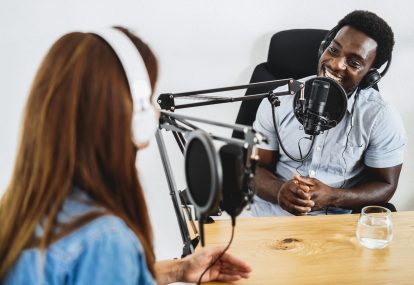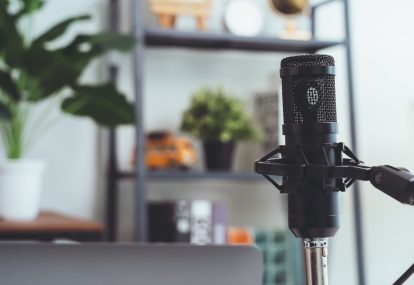Have you recently started your podcast and want to release episodes more consistently? Or maybe you’re thinking twice about entering the podcast space because of the tough competition. People have different opinions about the world of podcasting but one thing is clear: you don’t have to wait around until you have the time and money to set up a podcast studio at home.
Yes, you got that right. There are many ways to set up your podcast recording space at home — and get excellent, professional audio quality — without having to burn through your savings. You just have to be intentional about how you choose your space, how you design that space, and how you get the right equipment to get your podcast up and running.
If you’re just starting with an episode or want to step up your game after releasing a few ones, we recommend focusing on two questions: “Where should I record?” and “What equipment do I need?”
Setting up a home recording studio is easier than you think. We’ve got you covered with some tips for each of the questions so you can be more inspired to get a new show out into the world.
Where Should I Record?
Choose The Most “Ideal” Space
You have to dedicate a podcast room for your craft. That said, any spare room or empty basement or garage is not necessarily an ideal space. In fact, you should avoid large, empty spaces because they create echoes and reverb.
Consider the following when choosing your room for your home studio:
- The general rule is that the harder the surface, the more sound will bounce off of it. If you can, choose a space that has lots of soft surfaces. Windowless spaces are preferable but if you don’t have one, make sure to seal the frames to block out as much exterior noise as possible.
- Choose a room or space that doesn’t share walls with busy common areas to cut down on ambient noise.
- Did you know that a lot of podcasters record in their closets? If you can fit your equipment in a walk-in closet or wooden wardrobe, then it can be a perfect booth within a booth. Your clothes will do well to absorb the sound waves for that top-notch audio.
DIY Soundproofing
Soundproofing on a budget? No problem. You can soundproof your space using materials around your home. Pillows, for example, work perfectly to muffle the sound.
Simple ways to cover up hard surfaces and soften your surroundings include: using thick curtains, using carpets and rugs on the floor, using cardboard or acoustic foam on the walls and ceiling, laying a blanket or towel on your desk, and more.
What Equipment Do I Need?
Here are some of your equipment must-haves for setting up an awesome podcast recording studio at home.
- Computer or Laptop
This is a no-brainer but requires an emphasis just the same. If you already have one and you think it can handle the “requirements” of your podcast, then it’s fine to stick with it. But if you have the budget, it’s best to invest in a good computer or laptop model.
Look for a computer that is fast, reliable, and has a good amount of storage space. You’ll need to upload your audio and video files and install production software that records and edits your episodes.
- Microphone
Don’t just settle for the microphone that’s built into your computer or laptop. Mics can make or break the quality of your podcast audio so it’s best to get one or two mics with superb features. Narrow down your options based on how much you’re willing to spend and the types of sounds you’ll be recording.
Dynamic microphones are ideal for home studio setups because they are cheap, durable, and less sensitive — meaning they pick up less ambient noise. Condenser mics, meanwhile, tend to pick up all the noise around them. The upside is that condenser mics can record more detailed and crisp sounds and can save you more time during post-production. USB microphones are easier to use because they connect directly to your computer. XLR mics require a mixer or additional interface.
- Headphones
A good pair of headphones will help you prevent feedback, block out background noise, and monitor your audio closely. Go for comfort and quality when choosing your headphones. If you’re the type who moves a lot around your podcast studio, then wireless, lightweight headphones are ideal. Closed-back headphones are best if you’re after optimal isolation, meaning they won’t leak noise. Open-back ones have lesser isolation but offer the best sound quality.
- Software
Choose a software that works best for your podcast requirements. It’s what you’ll use to record, edit, mix, process, and master your audio. You can explore free, open-source options that work with popular operating systems. If you have the budget, invest in pro tools that can fine-tune your audio and edit out any mistakes and awkward silences with ease and finesse.
- Audio interface
This is the hardware that connects your microphones, headphones, and other production gear to your computer or laptop. You need this especially if you’re using XLR mics. Go for an interface that has at least two inputs — you will have to use two microphones if you’re recording with a guest or co-host.
That’s it! Use these basic tips to guide you in stepping up your podcast game at home. Get ready to host your episodes and capture that superb audio right in the comfort of your own podcast studio.




